Unit Chats
By Cindy Aossey and Bethany Neel
![]() Unit Chats are a type of math talk in which students are shown an image and asked a question such as
“How many do you see?” or “What numbers can you find?” Students are encouraged to think flexibly
about what can be counted, finding and describing different amounts depending on the unit they are using.
Unit Chats are a type of math talk in which students are shown an image and asked a question such as
“How many do you see?” or “What numbers can you find?” Students are encouraged to think flexibly
about what can be counted, finding and describing different amounts depending on the unit they are using.
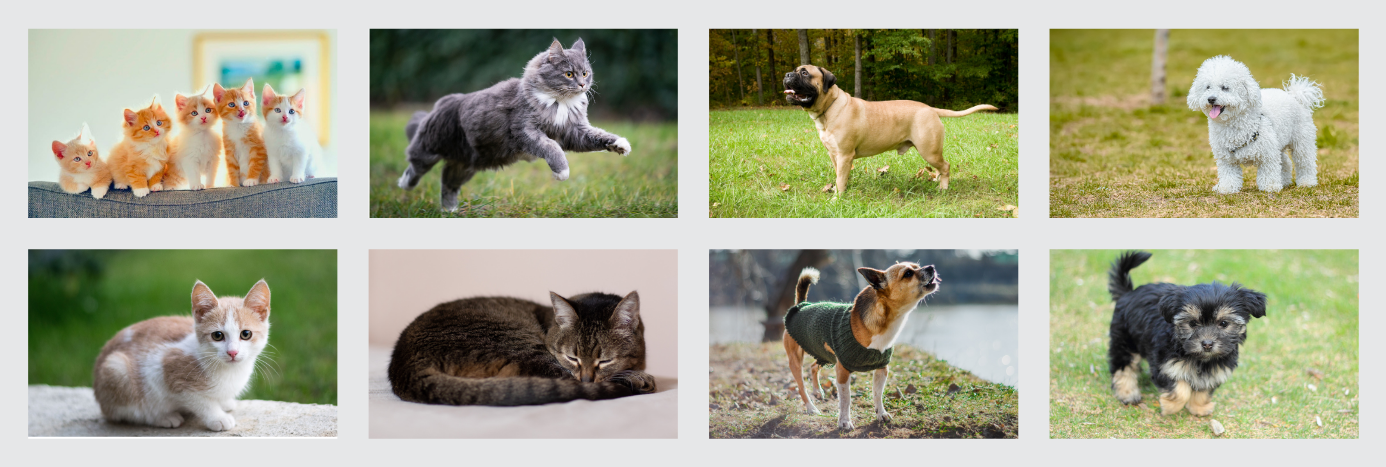
Consider the image above. How many? The answer varies depending on what you are counting. You might notice there are 8 pictures, 8 cats, 4 dogs, 2 rows, 12 pets, 6 kittens. You might notice 1 sleeping animal, 1 animal wearing clothes, or 6 animals are outside. You might figure out there are 48 paws, 24 eyes, or 12 noses.
Below you can see the recording from a third grade class discussing this image. Recorded in August, this was their first unit chat of the year.
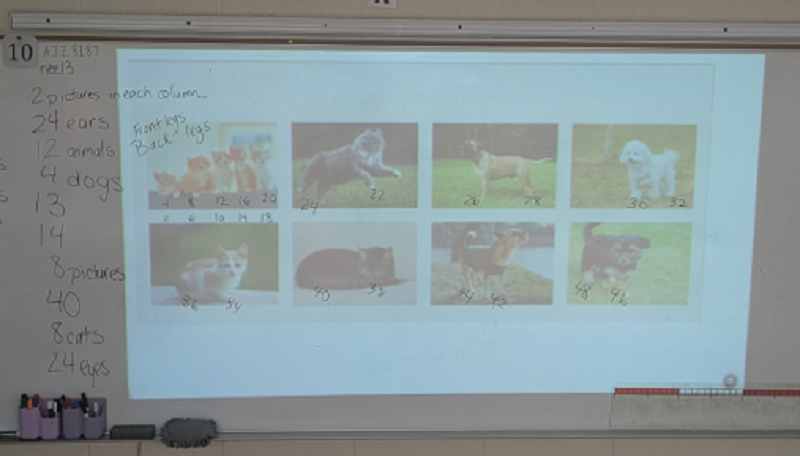
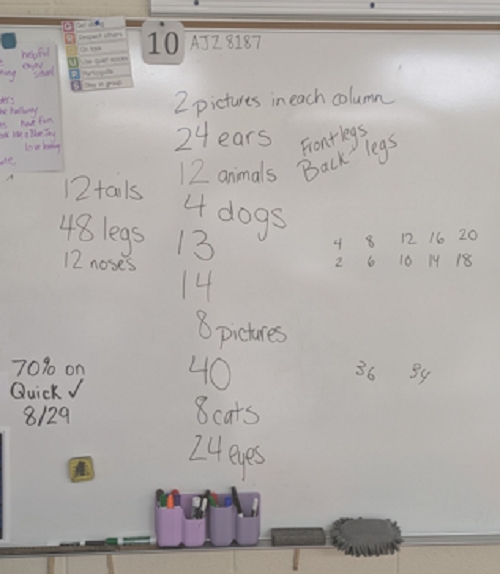
What do you notice? What do you wonder?
In Unit Chats, students are attending to precision (SMP 6) when they clearly communicate the amount and the unit. They use structure and notice relationships (SMP 7) and patterns (SMP 8) when they calculate amounts. For example, in the work above we can see that a student used a “front leg-back leg” pattern to count the legs by 2. As students build multiplicative reasoning, they will shift to more sophisticated strategies, such as calculating 4x12.
Unit chats aren't just for elementary students! Older students can find fractions and proportional relationships in an image such as this. They might notice that half of the pictures are of dogs, two-thirds of the animals are cats, the ratio of cats to dogs is 2:1, or the ratio of kittens to cats is 3:1.
Multiplicative Reasoning
Unit chats are a great way to develop multiplicative reasoning. Consider this image of dice. How many? Think flexibly!

Take a moment and jot down all of the amounts students might see in this image. Be sure to record your unit!
Do you see?
- Do you see 4 rows, 6 columns, or 24 dice?
- Do you see dot patterns of 2, 3, or 5?
- Do you see 3 colors of dice: 14 red, 5 green, and 5 white?
- Do you see 14 fives? Or maybe you paired each 2 with a 3 to make 5, and therefore, saw 19 fives?
- Do you see 95 pips? How did you figure it out? Did you use multiplication?
- Maybe you see even more numbers. How could you see 10? Or 20? Or 30?
Let's consider another picture. How might your students answer the question “How many?”
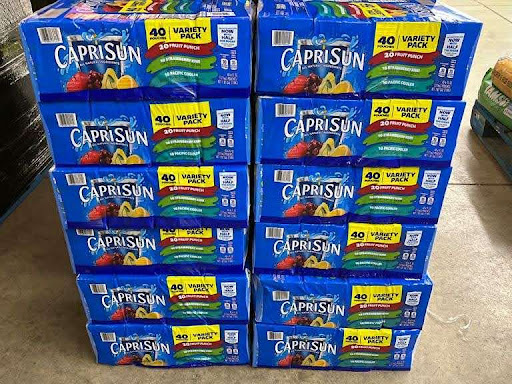
As before, the answer depends on the unit. Your students might notice 2 stacks, 6 boxes in a stack, 12 boxes, and figure out there are 480 drink pouches. They could also notice 12 bar codes, or 36 “swishes” in the labeling.
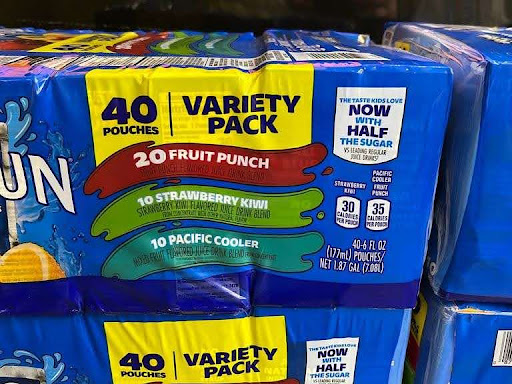
By providing a close-up image of one box, like this one, students might determine there are 120 Pacific Cooler drinks, 120 Strawberry Kiwi drinks, and 240 Fruit Punch drinks. They might even figure out the number of ounces or calories.
Fractional Reasoning
Unit chats can also be used to explore relationships between wholes and parts of a whole. Consider the picture below.

Students might initially see that as 10 pieces of fruit. With time and conversation, they can see 4 lemons and 6 half-lemons, seeing that as equivalent to 7 whole lemons.
Unit chats push students to think about structure, units, and relationships between units, and communicate their observations with precision.
Choosing an Image:
Unit Chats start with an interesting image that can be approached from a wide range of entry points. For young students, present real-world pictures with a variety of types of items that can be counted, such as our dogs and cats imagery, so that students develop their counting skills and awareness of units when counting. Prompts with structure and groupings encourage students to think flexibly about units and relationships between units. When items are arranged in arrays and equal groups, students can find multiplicative relationships. Items such as dice and dominoes naturally organize dots into easily recognized groups and can be easily arranged into rows and columns, such as the dice image previously considered. Collections of packaged items push students to think about the amount of an item they can't see. Pictures of coins give opportunities for students to think about both the number of coins as well as the value of the coins, for example relating 4 dimes to 40 cents. Arrangements of items cut into pieces, such as the lemons in the example above, support fractional reasoning. See the section “Resources for Implementing the Routine” below to access ready-to-use images!
Engaging in the Routine:
The routine starts by showing an image with an open question such as “How many?” or “What numbers do you see?”
You might ask students to:
- Consider the image individually, and then turn and talk with a partner.
- Share their thinking in a full-class discussion, using the same routines and hand-signals as a number talk.
- Jot down their answers on a small white board or recording sheet, being sure to include relevant units.
When facilitating, prompt students to name their unit. For example, if a student says “12”, ask the student to clarify 12 of what. Also, ask students to notice and use the relationships between answers, for example relating 12 animals to 48 paws.
Before facilitating a Unit Chat, it is helpful to anticipate a list of possible responses and consider how you might record student ideas. For example, you might want to project on a smart board or whiteboard, and circle or highlight what is being counted. Or you might list responses next to the image.
Sometimes students don't think about a range of units, especially when they are new to the routine. One way to encourage your students to think flexibly is to ask “How can you see…?” questions. For example, referring back to our prompt with cats & dogs, you might ask questions such as “How can you find 8?" or "How can you see 24?".
Unit chats can be used as a quick warm-up or be the launch into an extended lesson. They support students in thinking flexibly, communicating clearly, making use of structure, and coordinating units.
Resources for Implementing the Routine:
- Math for Love Unit Chats overview has an explanation of routine with several examples.
- Multiplicity Lab: The image bank for their Look-Think-Talk Routine is a great resource for unit chats. Images can be filtered by Big Idea, Grade band and/or Image Type. For Unit Chats images, we recommend starting your searches with the following Big Ideas: Thinking in Equal Groups; Connecting Area and Multiplicative Thinking; and Seeing and Creating Patterns.
- https://ntimages.weebly.com/photos.html This image bank includes numerous photos of real-word items. In particular, the “How many” and “Arrays” collections support multiplicative thinking, and the “Fractions” collection support thinking about the relationship between wholes and parts of a whole.